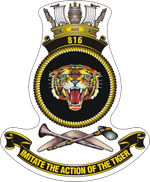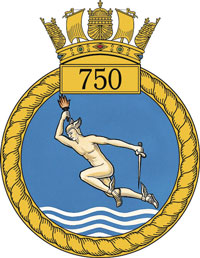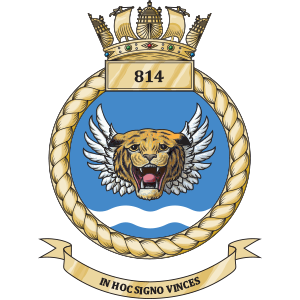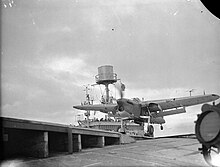
The Fairey Barracuda was a British carrier-borne torpedo and dive bomber designed by Fairey Aviation. It was the first aircraft of this type operated by the Royal Navy's Fleet Air Arm (FAA) to be fabricated entirely from metal.

The Fairey Albacore is a single-engine biplane torpedo bomber designed and produced by the British aircraft manufacturer Fairey Aviation. It was primarily operated by the Royal Navy Fleet Air Arm (FAA) during the Second World War.

816 Squadron is a Royal Australian Navy Fleet Air Arm squadron that started out as a Royal Navy unit, 816 Naval Air Squadron.
816 Naval Air Squadron was a Royal Navy Fleet Air Arm carrier based squadron formed at the start of the Second World War.

The Royal Navy Observer School grew out of HM Naval Seaplane Training School at RNAS Lee-on-Solent as a result of a series of changes of identity and parent unit. From 1918 until 1939 the Royal Air Force was responsible for naval aviation, including training and provision of aircrew to the Royal Navy. With the return of naval aviation to the Royal Navy on 24 May 1939, the Observer School was established as 750 Naval Air Squadron of the Fleet Air Arm. During World War II the squadron moved to Trinidad to continue training aircrew. It was temporarily disbanded in October 1945. The squadron reformed in 1952 and is currently based at RNAS Culdrose, where it trains approximately 30 Royal Navy observers every year.
821 Naval Air Squadron was a Royal Navy Fleet Air Arm carrier based squadron formed on 3 April 1933 with the transferral and amalgamation of the Fairey III aircraft from 446 and half of 455 Flight Flights Royal Air Force to the newly formed Fleet Air Arm of the Royal Air Force. The squadron operated during the Second World War.
810 Naval Air Squadron was a Royal Navy Fleet Air Arm carrier based squadron formed on 3 April 1933 with the amalgamation of the 12 Blackburn Dart aircraft from 463 and 44 Flight Flights Royal Air Force to the Fleet Air Arm. The squadron saw action during the Second World War, the Suez Crisis and the Korean War.

814 Naval Air Squadron or 814 NAS, nicknamed the Flying Tigers, is a squadron of the Royal Navy Fleet Air Arm. It is currently equipped with the AgustaWestland Merlin HM2 anti-submarine warfare helicopter and is based at Royal Naval Air Station (RNAS) Culdrose in Cornwall. The squadron was formed in December 1938 and has been disbanded and reformed several times.

824 Naval Air Squadron is a Royal Navy Fleet Air Arm squadron based at RNAS Culdrose and currently operating the AgustaWestland Merlin HM2 Operational Conversion Unit. It trains aircrew in Anti-Submarine warfare and Airborne Surveillance and Control.
830 Naval Air Squadron was a Royal Navy Fleet Air Arm squadron formed in Malta in July 1940 flying Fairey Swordfish torpedo bombers. During 1940–41 the squadron carried out attacks against the Axis supply effort in the Mediterranean. These included torpedo attacks against merchant ships and their Royal Italian Navy warship escorts, and also bomb attacks on port installations in Sicily and Libya. In July 1941 the squadron began operations with ASV RDF airborne radar to locate ships. Operations were mostly by night, with some dusk bombing sorties to Sicily. By March 1942 the squadron was so depleted that it merged with 828 Naval Air Squadron and continued operations. By March 1943, however, losses were such that the composite squadron ceased to exist.

703 Naval Air Squadron of the Fleet Air Arm of the Royal Navy was formed as a long-range catapult squadron on 3 March 1942 at RNAS Lee-on-Solent. During the Cold War, it was reformed as an experimental trials unit, and then as a helicopter training squadron. Since 2003, the squadron has formed the Royal Naval wing of the Defence Elementary Flying Training School at RAF Barkston Heath.

817 Naval Air Squadron was a unit of the Royal Navy Fleet Air Arm during the Second World War.

Operation Tungsten was a Second World War air raid conducted by the Royal Navy that targeted the German battleship Tirpitz at her base in Kaafjord in the far north of Norway on 3 April 1944.
Operation Mascot was an unsuccessful British carrier air raid conducted against the German battleship Tirpitz at her anchorage in Kaafjord, Norway, on 17 July 1944. Few of the British airmen were able to spot the battleship, and their attacks did not inflict any significant damage. Tirpitz was eventually disabled and then sunk by Royal Air Force heavy bombers later in the year.

717 Naval Air Squadron was a Naval Air Squadron of the Royal Navy's Fleet Air Arm which last disbanded in March 1946. It formed as a Torpedo Bomber Reconnaissance Training Squadron, at HMS Owl, RNAS Fearn, in July 1944, operating with Fairey Barracuda torpedo bomber aircraft. The squadron then moved to HMS Merganser, RNAS Rattray, in the October, continuing in Torpedo Bomber Reconnaissance training. In early 1946 the squadron received Blackburn Firebrand aircraft, with the objective of forming a Firebrand Conversion Unit, but this was never realised.

719 Naval Air Squadron was a Naval Air Squadron of the Royal Navy's Fleet Air Arm. It initially formed in 1944 as a Fighter Air Firing Training Squadron, at RNAS St Merryn, within the School of Air Combat. At the start of 1945 the squadron disbanded into 794 Naval Air Squadron. The squadron reformed in 1946 at RNAS Fearn as a Strike Training Squadron, before moving to RNAS Eglinton, where it became an Anti-submarine Training Squadron, disbanding there in 1949.
735 Naval Air Squadron was a Naval Air Squadron of the Royal Navy's Fleet Air Arm. It was active between 1943 and 1946 as an ASV radar Training Unit. Forming at RNAS Inskip in 1943, roughly one year later the squadron moved to RNAS Burscough. Various flights from the squadron moved on to form other Naval Air Squadrons, with 735 NAS eventually disbanding in 1946.

753 Naval Air Squadron was a Naval Air Squadron of the Royal Navy's Fleet Air Arm. It was active as an Observer Training Squadron from 1939 to 1946 as part of No.2 Observer School, forming out of the School of Naval Co-operation, in May 1939. Initially at RNAS Lee-on-Solent, the squadron moved to RNAS Arbroath just over one year later, in August 1940, following a German bombing attack on the air station. It spent four years operating out of Arbroath, before relocating again, this time to RNAS Rattray, where the squadron disbanded in August 1946.











